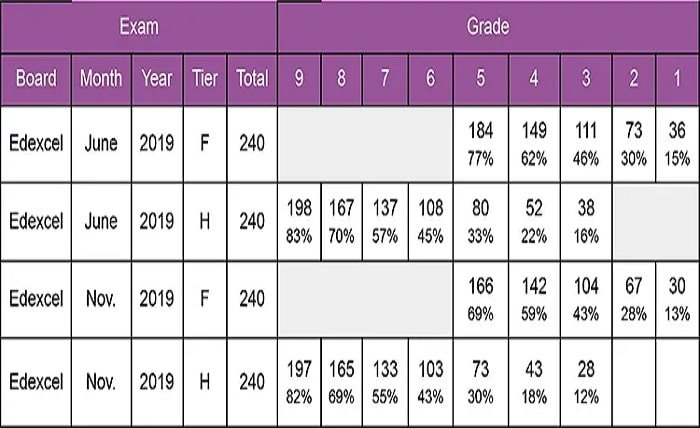Maths Genie Grade Boundaries: A Comprehensive Guide

Mathematics is a challenging subject, and for many students, the journey toward achieving top marks in GCSE and A-Level exams can feel daunting. Among the various tools and resources available for students preparing for these exams, Maths Genie stands out as one of the most popular websites. It provides free resources, including practice papers, revision notes, and video tutorials, to help students excel in their math exams. However, one key aspect that can significantly influence your results is the Maths Genie grade boundaries.
In this blog post, we’ll dive deep into what Maths Genie grade boundaries are, how they are determined, their impact on your results, and how you can use them to your advantage during your exam preparation. We’ll also answer some frequently asked questions to clear up any confusion.
What are Maths Genie Grade Boundaries?
Maths Genie grade boundaries are the minimum marks required to achieve a certain grade in your GCSE or A-Level mathematics exams. These boundaries serve as a benchmark, allowing students to understand how many marks they need to secure in order to achieve a specific grade, such as a grade 4 (pass), grade 5 (strong pass), or even the coveted grade 9.
Grade boundaries are set by the exam boards after the results are finalized, taking into account the overall performance of students. The maths genie grade boundaries are crucial because they give you an idea of where you stand in relation to other students, allowing you to gauge how well you need to perform in your exams to reach your desired grade.
How Are Maths Genie Grade Boundaries Set?
The setting of Maths Genie grade boundaries is a complex process, influenced by several factors. Exam boards, such as Edexcel, AQA, and OCR, analyze the overall performance of students across the country, looking at factors such as the difficulty of the exam, the performance of the cohort, and the standards expected for each grade.
For GCSE and A-Level exams, grade boundaries are typically set in the following way:
- Mark Distribution: Exam boards look at how marks are distributed across all students taking the exam.
- Historical Data: They also consider data from previous years to maintain consistency and fairness.
- Adjustments for Exam Difficulty: If the exam is deemed particularly difficult, the Maths Genie grade boundaries may be adjusted downward to ensure that students aren’t unfairly penalized.
Once these factors are analyzed, the exam boards set the boundaries for each grade. These boundaries are then made publicly available, often through platforms like Maths Genie, which is a valuable resource for students.
Why Are Maths Genie Grade Boundaries Important?
Understanding Maths Genie grade boundaries is essential for several reasons. First and foremost, these boundaries give you a clear understanding of what you need to achieve in your exam. This allows you to set realistic goals and develop a focused study plan.
The importance of Maths Genie grade boundaries extends beyond just providing clarity about the grades. They also help in tracking your progress throughout your revision. By practicing past papers and comparing your results to the grade boundaries, you can identify areas where you need to improve. If you consistently score above the minimum required marks for your desired grade, it’s a good indication that you’re on the right track.
Additionally, Maths Genie offers grade boundaries for both GCSE and A-Level exams, giving you the flexibility to gauge your progress regardless of the level you’re studying for.
How to Use Maths Genie Grade Boundaries in Your Exam Preparation
One of the best ways to use Maths Genie grade boundaries in your exam preparation is by reviewing past exam papers. Maths Genie provides a wealth of past papers for both GCSE and A-Level students, along with solutions and detailed mark schemes. By completing these practice papers, you can compare your scores against the grade boundaries to get a sense of where you stand.
Here are some tips on how to make the most of Maths Genie grade boundaries:
- Track Your Progress: Regularly complete practice papers and compare your scores to the grade boundaries. This will help you assess whether you’re on track to achieve your target grade.
- Focus on Weak Areas: If you’re scoring below the boundary for your target grade, spend extra time revising the areas where you’re struggling.
- Practice Under Timed Conditions: Try to complete practice papers within the exam’s time limits. This will help you build your time management skills and get comfortable with the pressure of the real exam.
By integrating maths genie grade boundaries into your study routine, you can create a more focused and strategic approach to your revision.
How Often Do Maths Genie Grade Boundaries Change?
The Maths Genie grade boundaries typically change every year, as they are based on the overall performance of the student cohort. This means that the boundaries for one year may not be the same as those for the next year, even if the exam papers are similar in difficulty.
It’s also important to note that the boundaries can vary between different exam boards. For instance, if you’re taking an Edexcel GCSE math exam, the Maths Genie grade boundaries for Edexcel may differ from those for AQA or OCR.
Therefore, it’s essential to stay updated with the latest Maths Genie grade boundaries to ensure you have the most accurate information when preparing for your exam. You can easily find the most recent grade boundaries on the Maths Genie website, which regularly updates this information.
The Impact of Maths Genie Grade Boundaries on Your Results
While the Maths Genie grade boundaries are an important tool in your preparation, it’s important to remember that they are not the only factor influencing your final results. Other elements, such as the quality of your revision, the time you dedicate to studying, and your ability to manage exam stress, all play a significant role in determining your success.
However, Maths Genie grade boundaries can still help you understand the level of performance required to achieve a particular grade. They provide a tangible goal that can motivate you to push yourself harder and aim higher.
It’s also worth noting that the grade boundaries can vary between different exam boards and qualification types (such as GCSE vs. A-Level). Always check the correct boundaries for your exam board and qualification level to avoid confusion.
Maths Genie Grade Boundaries for GCSE vs A-Level
Maths Genie grade boundaries for GCSE exams are often lower than those for A-Level exams due to the different levels of difficulty and the content covered in each qualification. GCSE exams are generally considered more foundational, while A-Level exams build upon the knowledge gained at the GCSE level and delve deeper into more advanced mathematical concepts.
As such, students may find that they need to score more highly to achieve the same grade at A-Level compared to GCSE. For example, a grade 7 in GCSE mathematics may require a different number of marks than a grade B in A-Level mathematics, even if both grades represent similar levels of achievement.
To ensure that you’re fully prepared, it’s important to be aware of the Maths Genie grade boundaries specific to your exam level. This will give you a clear idea of what to aim for, whether you’re working toward a GCSE or an A-Level qualification.
Conclusion
In conclusion, Maths Genie grade boundaries are a crucial resource for any student preparing for a GCSE or A-Level mathematics exam. They provide valuable insights into the level of performance required to achieve your desired grade, and they help you track your progress throughout your revision.
By incorporating Maths Genie grade boundaries into your study routine, you can ensure that you’re on the right path toward success. Use past papers, track your scores, and focus on areas where you need improvement to maximize your chances of achieving top marks.
FAQs
- What are the grade boundaries for Maths Genie GCSE? The grade boundaries for Maths Genie GCSE vary each year depending on the overall performance of the student cohort. Check the Maths Genie website for the latest information.
- How can I check the Maths Genie grade boundaries for A-Level exams? You can find the Maths Genie grade boundaries for A-Level exams on the Maths Genie website, where they are regularly updated.
- Do Maths Genie grade boundaries apply to all exam boards? Maths Genie grade boundaries are often based on the general performance of students, but they can vary between different exam boards (e.g., Edexcel, AQA, OCR). Always check the specific boundaries for your exam board.
- Can I still achieve a high grade if my score is below the grade boundary? If your score is below the Maths Genie grade boundary for your desired grade, it may be more difficult to achieve that grade. However, focusing on improving your weak areas can help boost your performance.
- How often do Maths Genie grade boundaries change? Maths Genie grade boundaries change each year based on the overall performance of the student cohort. Make sure to check for updates before your exam.




